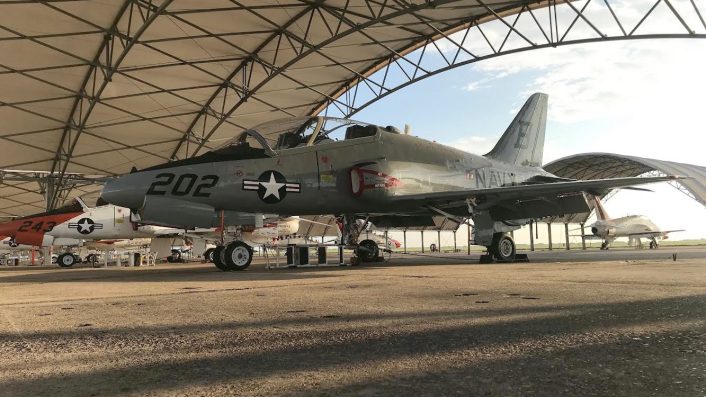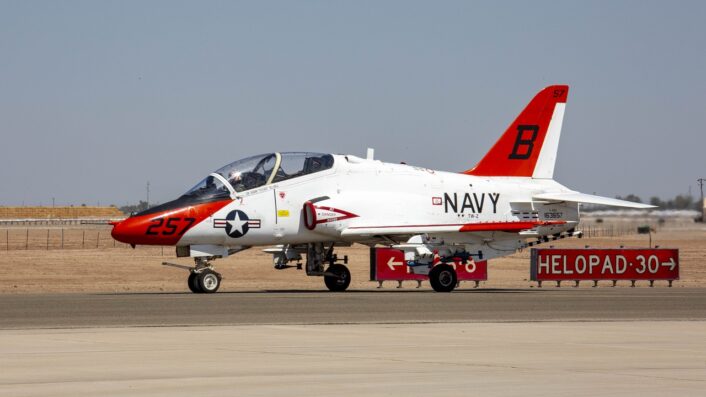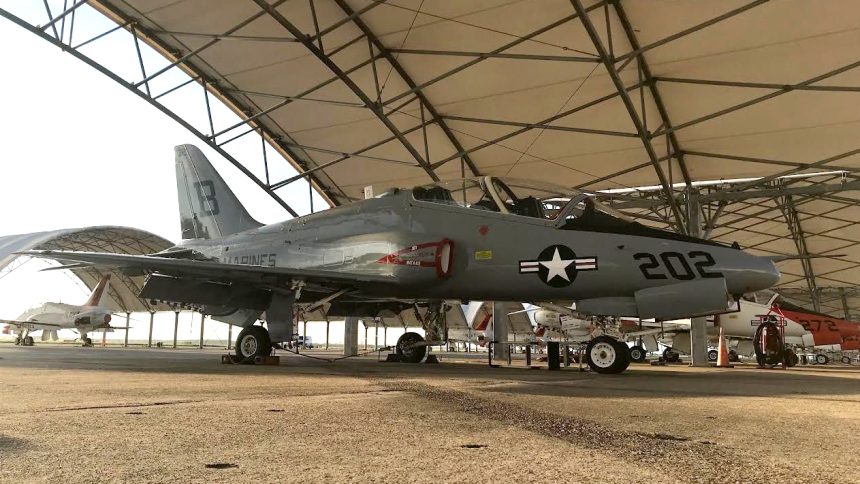The new glossy gray finish will replace the traditional orange-and-white livery of the U.S. Navy T-45 trainer aircraft.
The U.S. Navy’s Chief of Naval Air Training (CNATRA) has recently initiated a significant update to the paint scheme of its T-45 Goshawk aircraft. Traditionally adorned in an orange-and-white livery, the T-45s are now receiving a new glossy gray finish as part of a broader plan to modernize the appearance of CNATRA’s fleet. This change reflects a desire to align the training aircraft more closely with the tactical paint schemes of operational fleet aircraft, enhancing the professional experience for Student Naval Aviators (SNA) and their instructors.
The decision to move forward with the new color scheme was driven by feedback from instructors and students at the Naval Aviation Training Command (NATRACOM). The updated paint not only honors the Navy’s rich aviation history, with designs inspired by aircraft from World War II and the Korean War, but also gives training aircraft a more fleet-like appearance. This change is expected to make trainee pilots feel more integrated into the Navy’s operational environment as they prepare for future roles in the fleet.
For the T-45 Goshawk and other advanced flight training aircraft, the new paint scheme adopts varying shades of gray that closely resemble the tactical paint used on operational aircraft. This visual change helps bridge the gap between training and fleet service, reinforcing the identity of SNAs as part of the broader naval aviation community. The updated livery also includes distinctive tail markings that reflect the training air wing to which the aircraft belongs, adding a personal and unit-based identifier to each aircraft.
T-45 “202” is the first Training Air Wing 2 aircraft to adopt the new glossy grey coat.

According to a public release by CNATRA Public Affairs:
CNATRA utilizes four different type/model aircraft, with a fifth on the way, to support intermediate/advanced strike, intermediate/advanced multi-engine and advanced rotary training. These aircraft include the T-45C Goshawk, TH-57 Sea Ranger, TH-73 Thrasher (replacing the TH-57 Sea Ranger), and the T-44C Pegasus, soon to be replaced by the T-54A (King Air 260).
For these aircraft, the new paint scheme will utilize shades of a glossy grey coat to more closely resemble the tactical paint scheme (TPS) covering operational fleet aircraft. The shade of grey will closely resemble the specific counterpart for each training aircraft. For example, the coat of the TH-73 Thrasher will reflect the darker tactical paint scheme of the MH-60S Seahawk, while the T-54A will have a lighter coat similar to the P-8A Poseidon.
Colored markings will contrast the grey paint for lettering and symbols like the United States roundel. Additionally, the tail of each aircraft will feature a distinctive color scheme identifying the specific training air wing (TAW) an aircraft is assigned to, typically referred to as a tail “flash.”
Naval Aviators and instructors, such as Lt. Zachary Pennington from Helicopter Training Squadron (HT) 8, have expressed support for the changes. Pennington highlighted the pride that comes with seeing the aircraft painted in a scheme more aligned with the rest of the fleet, stating that it fosters a sense of belonging among trainees. The transition to the new paint will occur gradually over the coming years, with aircraft receiving the updated look as their existing orange-and-white paint schemes reach the end of their life cycle. By the end of this phased transition, the iconic orange-and-white paint scheme will disappear from the fleet, replaced by the modern glossy gray look.
In a LinkedIn discussion between two former U.S. Navy pilots, there were conflicting views regarding the “stigma” associated with flying aircraft painted in the traditional orange-and-white training scheme. One pilot expressed that the recent decision to update the paint scheme is beneficial for morale, suggesting that the orange-and-white color had always carried a certain stigma and that the new design better prepares students for fleet operations. However, another pilot disagreed, arguing that there was no stigma associated with the paint itself and that any such negative perception might stem from institutional factors rather than the aircraft’s appearance. This exchange highlights differing opinions on whether the old color scheme had any real impact on pilot morale or pride.
Given that the majority of modern military aircraft are now painted in overall gray, this author, for what it’s worth, personally preferred the traditional orange-and-white color scheme over the new design. The older livery, with its bright and distinctive look, stood out more compared to the uniform gray seen on most aircraft today.
Anyway, this move represents a significant shift for CNATRA, aligning training aircraft with the operational fleet and ensuring that naval aviators feel part of a unified force from the start of their careers.
CNATRA’s primary mission is to develop, guide, and produce top-tier Naval Aviators who are equipped to excel in any situation, whether it be during competition, in times of crisis, or in the midst of conflict. Operating out of NAS Corpus Christi, CNATRA manages five training air wings located across Florida, Mississippi, and Texas. These wings collectively support 17 training squadrons. In addition to its core responsibilities, CNATRA also oversees the prestigious Navy Flight Demonstration Squadron, the Blue Angels, and manages the training programs for all fleet replacement squadrons.
Interestingly, the change in the paint scheme comes at a time when the future of the T-45’s replacement remains uncertain. The Undergraduate Jet Training System (UJTS) program, initially expected to announce its contract winner in fiscal year 2026, has now delayed the decision until fiscal year 2028.
The Navy is actively seeking a replacement for the T-45, driven by a series of past issues, including problems with the oxygen supply system and a recent fleet-wide grounding due to an “in-flight engine malfunction.” This is the second such grounding in two years. The BAE Systems Hawk, on which the T-45 is based and used by several countries including Britain and India, has also experienced similar issues.

Despite only being in service since 1988, making it 36 years old, the T-45 is relatively young compared to other U.S. military aircraft. Its Air Force counterpart, the T-38 Talon, for example, has been in service for 65 years. As we reported in July, Naval Air Station Kingsville’s Training Air Wing 2 (TW-2) recently reached a major milestone with its T-45C Goshawk fleet, celebrating 1,000,000 flight hours with the type.
The Navy is currently considering three potential replacements for the T-45: the Boeing-Saab T-7 (winner of the Air Force’s T-X program), the Lockheed Martin-KAI T-50, and the Leonardo-Textron M-346N. Interestingly, Navy officials have indicated that the new trainer may not need to be carrier-capable, meaning it might not require an arresting hook or be designed for carrier operations. For now, the plan is to remove carrier qualification from the training curriculum, relying instead on Field Carrier Landing Practice (FCLP), which simulates carrier landings on land-based short runways. If the Navy reverses this decision, significant and costly redesigns would be necessary to make any of the competing aircraft suitable for carrier operations.
According to the Request for Information, the Navy plans to acquire a total of 145 new training aircraft, with an annual procurement rate of 25 planes. The contract will also include simulators, operational equipment, and training curriculum.









